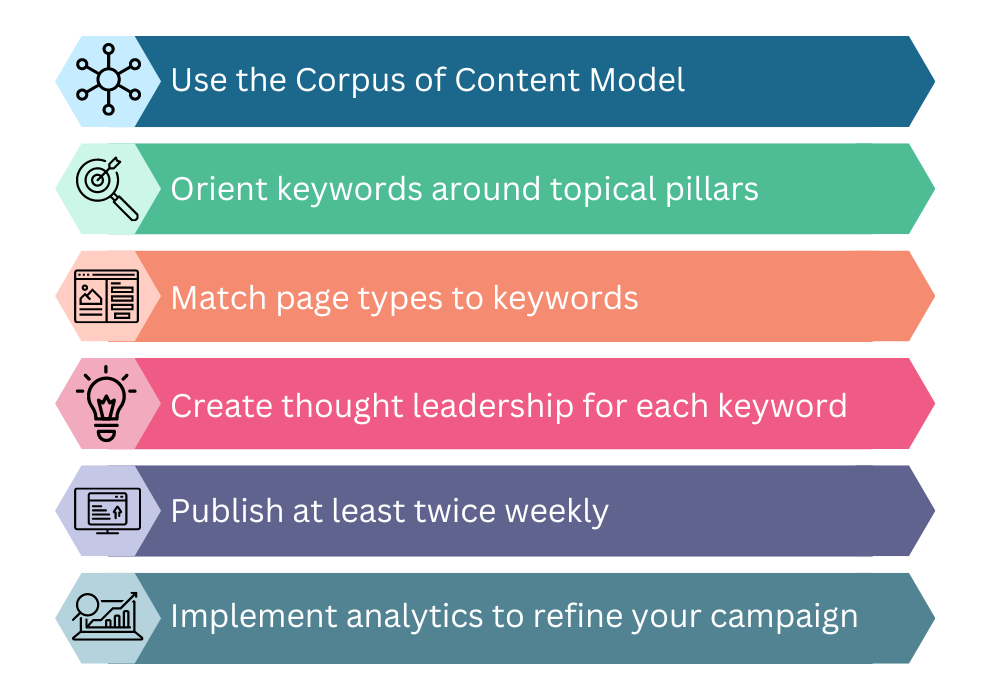Search engine optimization (SEO) is crucial for online success. Good SEO helps you rank higher in search results. This means more visibility and traffic to your website. To achieve good SEO, it’s important to invest in website ranking solutions that will help improve your online presence. These solutions may include keyword research, link building, and on-page optimization to ensure that your website is easily found by potential customers.
Understanding SEO can be challenging, but it’s worth the effort. It helps your website get more visitors. Quality SEO practices can make a big difference. They improve your site’s visibility and user experience. Learning the best SEO practices can boost your online presence.
This guide will cover the essentials. It will help you understand what works best. By following these practices, you can enhance your site’s performance. Let’s dive into the best SEO practices to make your website shine.

Credit: firstpagesage.com
Table of Contents
ToggleKeyword Research
Effective Keyword Research is the backbone of any successful SEO strategy. It helps you understand what your audience is searching for, ensuring your content reaches the right people. Let’s dive into the essential aspects of keyword research.
Finding Relevant Keywords
To find relevant keywords, start with brainstorming. Think about terms your audience might use. Use tools like Google Keyword Planner, Ubersuggest, and Ahrefs. These tools provide insight into what people are searching for in your niche.
- Google Keyword Planner: Offers keyword ideas and search volume.
- Ubersuggest: Shows keyword ideas and competition.
- Ahrefs: Provides extensive keyword data and difficulty scores.
Look for long-tail keywords. These are phrases with three or more words. They are specific and have less competition. For instance, instead of “shoes”, use “best running shoes for women”. This attracts a more targeted audience.
Analyzing Keyword Competition
After finding relevant keywords, analyze their competition. This helps you understand how hard it is to rank for those keywords.
Use tools to check the keyword difficulty score. Here are some useful tools:
| Tool | Keyword Difficulty Score |
|---|---|
| Ahrefs | Rates difficulty on a scale of 0-100 |
| SEMrush | Shows keyword difficulty as a percentage |
| Moz | Provides a score out of 100 |
Focus on keywords with a moderate difficulty score. This balance between search volume and competition is crucial. High difficulty keywords are hard to rank for. Low difficulty keywords might have low search volume.
Check the top-ranking pages for your chosen keywords. Analyze their content. See what makes them rank high. Look at their word count, content quality, and backlink profile. This gives you a benchmark to aim for.
Remember, effective keyword research is a continuous process. Regularly update your keywords to stay relevant. This keeps your content fresh and competitive.
On-page Optimization
On-page optimization is a key part of SEO. It involves tweaking elements on your website to improve rankings. It includes optimizing title tags, improving meta descriptions, and many other factors. Let’s look at some best practices.
Optimizing Title Tags
Title tags are important for SEO. They tell search engines what your page is about. Here are some tips for optimizing title tags:
- Include the main keyword at the beginning of the title.
- Keep the title under 60 characters.
- Make the title relevant and engaging.
- Use unique titles for each page.
A good title tag can increase your CTR (Click-Through Rate). This means more visitors to your site. Here’s an example:
Improving Meta Descriptions
Meta descriptions give a summary of your page. They appear under the title in search results. Here are some tips for improving meta descriptions:
- Include your main keyword in the description.
- Keep it under 160 characters.
- Make it compelling and informative.
- Use a call-to-action to encourage clicks.
A well-crafted meta description can improve your CTR. Here’s an example:
By focusing on these elements, you can boost your site’s visibility. Remember, on-page optimization is crucial for SEO success.
Quality Content Creation
Creating quality content is essential for effective SEO. Quality content attracts users and retains their attention. It also improves your search engine rankings. Below, we discuss best practices for quality content creation.
Writing Engaging Content
Engaging content keeps readers on your page longer. This reduces bounce rates and signals to search engines that your content is valuable. Here are some tips for writing engaging content:
- Use short sentences and simple language.
- Break up text with headings and subheadings.
- Incorporate images and videos to make the content visually appealing.
- Ask questions to involve the reader.
- Provide practical tips and solutions to problems.
Utilizing Long-form Content
Long-form content is detailed and comprehensive. It often covers a topic in-depth. Long-form content can improve your SEO because it provides more value to readers. Here are some benefits of long-form content:
| Benefit | Explanation |
|---|---|
| Increased Time on Page | Readers spend more time on detailed articles. |
| More Keywords | Long articles can naturally include more keywords. |
| Better Backlinks | High-quality content attracts more backlinks. |
To create effective long-form content, consider these steps:
- Choose a topic relevant to your audience.
- Research thoroughly to provide accurate information.
- Organize content with clear headings and subheadings.
- Use bullet points and numbered lists for readability.
- Include multimedia elements to break up the text.
By focusing on quality content creation, you can enhance your SEO strategy. Engaging and long-form content will help you attract and retain more visitors.
Technical Seo
Technical SEO is the backbone of a successful SEO strategy. It involves optimizing the infrastructure of your website to ensure search engines can crawl and index it effectively. This, in turn, helps improve your site’s visibility and ranking on search engines. Let’s explore two crucial aspects of technical SEO: Improving Site Speed and Ensuring Mobile-Friendliness.
Improving Site Speed
Site speed is a critical ranking factor. Users expect pages to load quickly. A slow website can lead to high bounce rates and lower rankings. Here are some tips to enhance your site’s speed:
- Optimize Images: Use compressed and appropriately sized images.
- Use Browser Caching: Store resource files on local devices.
- Minimize HTTP Requests: Reduce the number of elements on a page.
- Enable Compression: Use tools like Gzip to compress files.
- Prioritize Above-the-Fold Content: Ensure the top content loads first.
Ensuring Mobile-friendliness
Mobile-friendliness is essential. More users access the web via mobile devices. A mobile-friendly site enhances user experience and boosts rankings. Consider these steps to make your site mobile-friendly:
- Responsive Design: Use responsive design to adapt to different screen sizes.
- Mobile-Optimized Content: Ensure content is readable without zooming.
- Touch-Friendly Buttons: Make buttons large enough for easy tapping.
- Fast Loading Times: Ensure quick load times on mobile devices.
- Viewport Configuration: Use the correct meta viewport tag.
| Technique | Description |
|---|---|
| Optimize Images | Compress and resize images for faster loading. |
| Browser Caching | Store files on local devices to reduce load time. |
| Responsive Design | Adapt site layout to fit different screens. |
| Mobile-Optimized Content | Ensure content is easily readable on mobile devices. |
Link Building
Link building is a vital part of SEO strategies. It helps improve your site’s ranking on search engines. The process involves acquiring links from other websites to your own. This indicates to search engines that your site is credible and valuable. Below are some effective methods for link building.
Acquiring Backlinks
Backlinks are links from other websites to your own. They are crucial for SEO success. Here are some ways to acquire them:
- Guest Blogging: Write articles for other sites and include a link back to your own.
- Broken Link Building: Find broken links on other websites and suggest your content as a replacement.
- Content Promotion: Share your content on social media and reach out to influencers.
Focus on creating high-quality, valuable content. This attracts more backlinks naturally.
Internal Linking Strategies
Internal links connect one page of your website to another. This helps users navigate your site and improves SEO. Here are some strategies:
- Use Descriptive Anchor Text: Make sure the text you link from is relevant and descriptive.
- Link to Important Pages: Direct more links to key pages to boost their search engine ranking.
- Update Old Content: Add links to new content from older posts.
Internal linking not only helps with SEO but also improves user experience.

Credit: www.semrush.com
User Experience
User experience is a critical component in SEO. It affects how visitors interact with your site. A positive experience can boost engagement and conversions. This section will explore two key aspects: enhancing site navigation and reducing bounce rate.
Enhancing Site Navigation
Good navigation helps users find what they need quickly. It also keeps them on your site longer. Here are some tips to enhance site navigation:
- Organize your menu: Use clear, logical categories.
- Include a search bar: Make it easy to find.
- Use breadcrumb trails: Show users their path.
- Limit menu items: Keep it simple and uncluttered.
A well-organized menu can improve the user experience. It guides visitors to the information they need. This can lead to higher engagement and lower bounce rates.
Reducing Bounce Rate
A high bounce rate can hurt your SEO. It signals to search engines that your site may not be relevant. Here are some strategies to reduce bounce rate:
- Improve page load speed: Slow pages can drive users away.
- Use engaging visuals: Images and videos can capture attention.
- Write clear, concise content: Avoid fluff and get to the point.
- Ensure mobile-friendliness: Many users browse on mobile devices.
Reducing bounce rate involves making your site more engaging. Faster load times, engaging visuals, and clear content keep users on your site longer. This can improve your search rankings and user satisfaction.
Local Seo
Local SEO is crucial for businesses that serve a specific area. It helps you attract customers in your location. This ensures you stand out in local searches. Here are two key practices:
Optimizing Google My Business
Google My Business (GMB) is vital for local SEO. It displays your business on Google Maps and search results. Follow these steps to optimize your GMB profile:
- Complete all fields: Ensure your business name, address, and phone number are correct.
- Add photos: Upload high-quality images of your business.
- Choose the right category: Select the most relevant category for your business.
- Update regularly: Keep your profile updated with new posts and offers.
Gaining Local Reviews
Local reviews impact your business’s visibility and credibility. Positive reviews attract more customers. Here’s how to gain more reviews:
- Ask for reviews: Request reviews from satisfied customers.
- Make it easy: Provide links to your GMB profile for easy access.
- Respond to reviews: Reply to both positive and negative reviews promptly.
- Show appreciation: Thank customers for their feedback.
By following these steps, you can enhance your local SEO and draw more local customers.

Credit: www.linkedin.com
Measuring Success
Measuring Success in SEO is crucial to ensure your efforts are paying off. It’s not just about driving traffic. You need to understand how well your strategies are working. Tracking the right metrics and adjusting your strategies based on data are essential steps.
Tracking Seo Metrics
To measure your SEO success, track important metrics. Here are some key metrics to focus on:
- Organic Traffic: The number of visitors coming from search engines.
- Keyword Rankings: Track the positions of your target keywords.
- Backlinks: The number and quality of links pointing to your site.
- Click-Through Rate (CTR): The percentage of users who click on your search results.
- Bounce Rate: The percentage of visitors who leave your site after viewing only one page.
- Conversion Rate: The percentage of visitors who take a desired action on your site.
Adjusting Strategies Based On Data
Once you have tracked your SEO metrics, it’s time to adjust your strategies. Here’s how you can do it: First, identify which keywords are performing well and which ones are not. This can be done through rank tracking tools, which will show you where your website ranks for specific keywords. Once you have this information, you can optimize your content to focus on the high-performing keywords and improve your rankings. Additionally, monitor your website’s traffic and user engagement to see if the changes you make to your SEO strategies are having a positive impact. By regularly tracking and adjusting your SEO strategies, you can ensure that your website remains competitive and attracts the right audience.
- Analyze the Data: Look at the metrics to see what’s working and what’s not.
- Identify Weak Areas: Find out which pages have high bounce rates or low conversion rates.
- Make Improvements: Optimize content, improve page speed, and enhance user experience based on your findings.
- Test New Strategies: Implement new techniques and track their performance.
- Repeat the Process: Continuously monitor metrics and adjust strategies as needed.
What are the key strategies for boosting website rankings through SEO practices?
To boost your site’s rankings through SEO, consider on-page optimization, creating high-quality content, building backlinks, and improving website speed. Conduct keyword research to target relevant terms and phrases, and regularly monitor and analyze your site’s performance to make adjustments as needed. Utilize SEO audit tools to identify any technical issues on your site, such as broken links or crawl errors, and make the necessary fixes to improve user experience and search engine visibility. Additionally, staying up to date with algorithm changes and industry best practices is essential for maintaining a successful SEO strategy. By staying proactive and implementing these tactics, you can effectively improve your site’s rankings and drive more organic traffic.
What are the best SEO practices for using rank tracking tools to boost website rankings?
If you want to boost your seo strategy with rank tracking, it’s important to focus on using the best practices. This includes regularly monitoring your website’s rankings, tracking keyword performance, analyzing competitor rankings, and making data-driven decisions to improve your overall SEO efforts.
Frequently Asked Questions
What Are The Best Seo Practices?
Implement keyword research, optimize meta tags, create quality content, and ensure mobile-friendliness. Improve page speed and use internal linking. Regularly update content.
How Important Is Mobile Optimization For Seo?
Mobile optimization is crucial for SEO. Google prioritizes mobile-friendly websites. Ensure responsive design and fast loading times for better rankings.
Why Is Keyword Research Essential?
Keyword research identifies terms your audience searches for. It helps create targeted content, improving visibility and traffic.
How Does Content Quality Affect Seo?
High-quality content keeps users engaged. It reduces bounce rates and increases time on site. Google rewards valuable content.
What are the best tools to use to boost my website’s rankings using SEO practices?
To boost website visibility with seo ranking tools, it’s essential to use top-notch keyword research tools, such as SEMrush or Ahrefs, to identify high-performing keywords. Additionally, utilizing on-page optimization tools like Yoast SEO and creating quality content with tools like Grammarly can further enhance your website’s rankings.
Conclusion
Effective SEO practices help boost your website’s visibility. Stick to the basics. Use keywords wisely. Focus on quality content. Optimize images and links. Keep your site fast and mobile-friendly. Monitor your performance regularly. Implement these strategies, and you’ll see improvements.
Remember, consistency is key. Small changes make a big difference. Happy optimizing!








